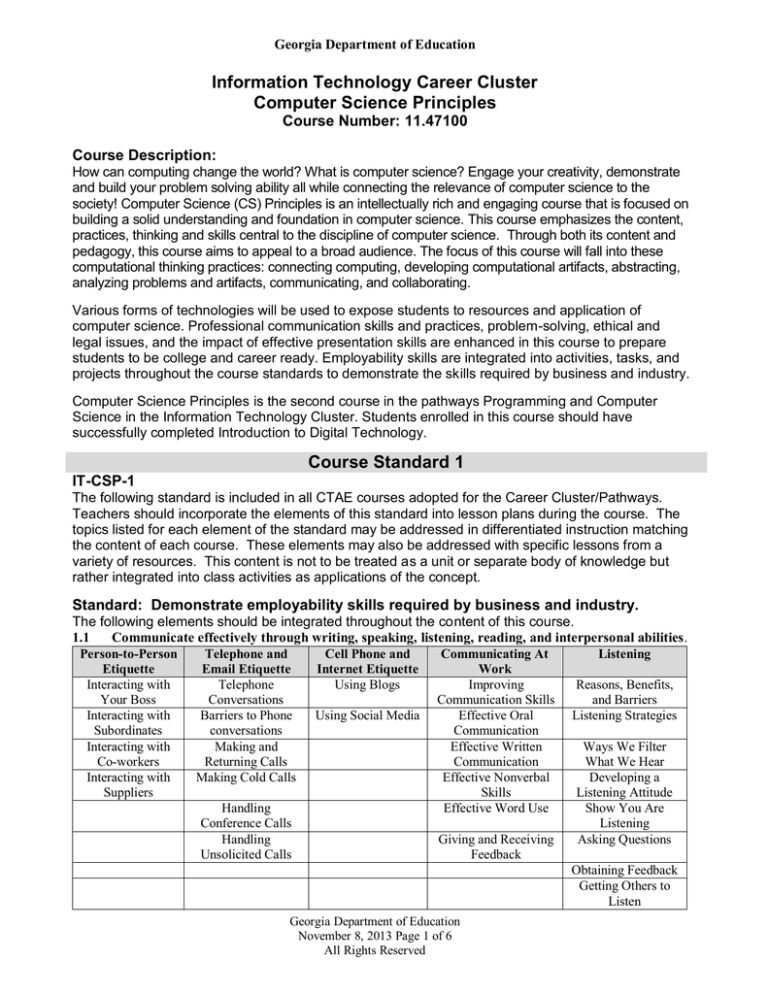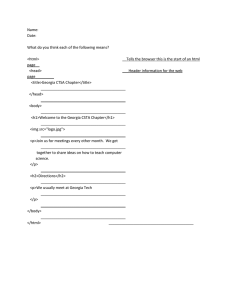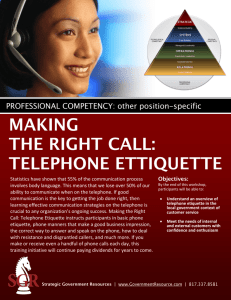
Georgia Department of Education
Information Technology Career Cluster
Computer Science Principles
Course Number: 11.47100
Course Description:
How can computing change the world? What is computer science? Engage your creativity, demonstrate
and build your problem solving ability all while connecting the relevance of computer science to the
society! Computer Science (CS) Principles is an intellectually rich and engaging course that is focused on
building a solid understanding and foundation in computer science. This course emphasizes the content,
practices, thinking and skills central to the discipline of computer science. Through both its content and
pedagogy, this course aims to appeal to a broad audience. The focus of this course will fall into these
computational thinking practices: connecting computing, developing computational artifacts, abstracting,
analyzing problems and artifacts, communicating, and collaborating.
Various forms of technologies will be used to expose students to resources and application of
computer science. Professional communication skills and practices, problem-solving, ethical and
legal issues, and the impact of effective presentation skills are enhanced in this course to prepare
students to be college and career ready. Employability skills are integrated into activities, tasks, and
projects throughout the course standards to demonstrate the skills required by business and industry.
Computer Science Principles is the second course in the pathways Programming and Computer
Science in the Information Technology Cluster. Students enrolled in this course should have
successfully completed Introduction to Digital Technology.
Course Standard 1
IT-CSP-1
The following standard is included in all CTAE courses adopted for the Career Cluster/Pathways.
Teachers should incorporate the elements of this standard into lesson plans during the course. The
topics listed for each element of the standard may be addressed in differentiated instruction matching
the content of each course. These elements may also be addressed with specific lessons from a
variety of resources. This content is not to be treated as a unit or separate body of knowledge but
rather integrated into class activities as applications of the concept.
Standard: Demonstrate employability skills required by business and industry.
The following elements should be integrated throughout the content of this course.
1.1
Communicate effectively through writing, speaking, listening, reading, and interpersonal abilities.
Person-to-Person
Telephone and
Cell Phone and
Communicating At
Listening
Etiquette
Email Etiquette
Internet Etiquette
Work
Interacting with
Telephone
Using Blogs
Improving
Reasons, Benefits,
Your Boss
Conversations
Communication Skills
and Barriers
Interacting with
Barriers to Phone
Using Social Media
Effective Oral
Listening Strategies
Subordinates
conversations
Communication
Interacting with
Making and
Effective Written
Ways We Filter
Co-workers
Returning Calls
Communication
What We Hear
Interacting with
Making Cold Calls
Effective Nonverbal
Developing a
Suppliers
Skills
Listening Attitude
Handling
Effective Word Use
Show You Are
Conference Calls
Listening
Handling
Giving and Receiving
Asking Questions
Unsolicited Calls
Feedback
Obtaining Feedback
Getting Others to
Listen
Georgia Department of Education
November 8, 2013 Page 1 of 6
All Rights Reserved
Georgia Department of Education
Nonverbal
Communication
Communicating
Nonverbally
Reading Body Language
and mixed Messages
Matching Verbal and
Nonverbal communication
Improving Nonverbal
Indicators
Nonverbal Feedback
Showing Confidence
Nonverbally
Showing Assertiveness
1.2
Written
Communication
Writing Documents
Constructive
Criticism in Writing
Speaking
Using Language
Carefully
One-on-One
Conversations
Small Group
Communication
Large Group
Communication
Making Speeches
Involving the
Audience
Answering Questions
Visual and Media Aids
Errors in Presentation
Applications and Effective
Résumés
Completing a Job Application
Writing a Cover Letter
Things to Include in a Résumé
Selling Yourself in a Résumé
Terms to Use in a Résumé
Describing Your Job Strengths
Organizing Your Résumé
Writing an Electronic Résumé
Dressing Up Your Résumé
Demonstrate creativity by asking challenging questions and applying innovative procedures and
methods.
Teamwork and Problem Solving
Meeting Etiquette
Thinking Creatively
Preparation and Participation in Meetings
Taking Risks
Conducting Two-Person or Large Group Meetings
Building Team Communication
Inviting and Introducing Speakers
Facilitating Discussions and Closing
Preparing Visual Aids
Virtual Meetings
1.3
Exhibit critical thinking and problem solving skills to locate, analyze and apply information in
career planning and employment situations.
Problem
Customer Service The Application Process
Interviewing
Finding the Right
Solving
Skills
Job
Transferable
Gaining Trust and
Providing Information,
Preparing for an
Locating Jobs and
Job Skills
Interacting with
Accuracy and Double
Interview
Networking
Customers
Checking
Becoming a
Learning and
Online Application
Questions to Ask in
Job Shopping
Problem Solver
Giving Customers
Process
an Interview
Online
What They Want
Identifying a
Keeping Customers
Following Up After
Things to Include
Job Search
Problem
Coming Back
Submitting an
in a Career
Websites
Application
Portfolio
Becoming a
Seeing the
Effective Résumés:
Traits Employers
Participation in Job
Critical Thinker
Customer’s Point
are Seeking
Fairs
Managing
Selling Yourself and Matching Your Talents to
Considerations
Searching the
the Company
a Job
Before Taking a
Classified Ads
Job
Handling Customer
When a Résumé Should
Using Employment
Complaints
be Used
Agencies
Strategies for
Landing an
Customer Service
Internship
Staying Motivated
to Search
Georgia Department of Education
November 8, 2013 Page 2 of 6
All Rights Reserved
Georgia Department of Education
1.4
Model work readiness traits required for success in the workplace including integrity, honesty,
accountability, punctuality, time management, and respect for diversity.
Workplace
Personal
Employer
Business Etiquette
Communicating at
Ethics
Characteristics
Expectations
Work
Demonstrating
Demonstrating a
Behaviors Employers
Language and
Handling Anger
Good Work Ethic
Good Attitude
Expect
Behavior
Behaving
Gaining and
Objectionable
Keeping Information
Dealing with
Appropriately
Showing Respect
Behaviors
Confidential
Difficult Coworkers
Maintaining
Demonstrating
Establishing
Avoiding Gossip
Dealing with a
Honesty
Responsibility
Credibility
Difficult Boss
Playing Fair
Showing
Demonstrating Your
Appropriate Work
Dealing with
Dependability
Skills
Email
Difficult Customers
Using Ethical
Being Courteous
Building Work
Cell Phone Etiquette Dealing with Conflict
Language
Relationships
Showing
Gaining
Appropriate Work
Responsibility
Coworkers’ Trust
Texting
Reducing
Persevering
Understanding
Harassment
Copyright
Respecting
Handling
Social Networking
Diversity
Criticism
Making
Showing
Truthfulness a
Professionalism
Habit
Leaving a Job
Ethically
1.5
Apply the appropriate skill sets to be productive in a changing, technological, diverse workplace to
be able to work independently and apply team work skills.
Expected Work Traits
Teamwork
Time Management
Demonstrating Responsibility
Teamwork Skills
Managing Time
Dealing with Information Overload
Reasons Companies Use Teams
Putting First Things First
Transferable Job Skills
Decisions Teams Make
Juggling Many Priorities
Managing Change
Team Responsibilities
Overcoming Procrastination
Adopting a New Technology
Problems That Affect Teams
Organizing Workspace and Tasks
Expressing Yourself on a Team
Staying Organized
Giving and Receiving Constructive
Finding More Time
Criticism
Managing Projects
Prioritizing Personal and Work Life
1.6
Present a professional image through appearance, behavior and language.
On-the-Job Etiquette Person-to-Person Etiquette Communication Etiquette
Presenting Yourself
Using Professional
Meeting Business
Creating a Good Impression
Looking Professional
Manners
Acquaintances
Introducing People
Meeting People for the First
Keeping Phone Calls
Dressing for Success
Time
Professional
Appropriate Dress
Showing Politeness
Proper Use of Work Email
Showing a Professional
Attitude
Business Meal
Proper Use of Cell Phone
Using Good Posture
Functions
Behavior at Work
Proper Use in Texting
Presenting Yourself to
Parties
Associates
Behavior at
Accepting Criticism
Conventions
Georgia Department of Education
November 8, 2013 Page 3 of 6
All Rights Reserved
Georgia Department of Education
International Etiquette
Demonstrating
Leadership
Cross-Cultural Etiquette
Working in a Cubicle
Support of CTAE Foundation Course Standards and Georgia Standards of Excellence
L9-10RST 1-10 and L9-10WHST 1-10:
Georgia Standards of Excellence ELA/Literacy standards have been written specifically for
technical subjects and have been adopted as part of the official standards for all CTAE courses.
Course Standard 2
IT-CSP-2
Create digital artifacts that foster creative expression including programs, digital music,
videos, images, documents, and combinations of these such as infographics,
presentations, and web pages.
2.1 Understand and use software tools by combining and modifying existing artifacts or by
creating new artifacts.
2.2 Collaborate as a team to develop an artifact that represents multiple perspectives.
2.3 Show functionality and suitability (or appropriateness) of a computational artifact.
2.4 Develop a program for creative expression or to satisfy personal curiosity which may have
visual, audible, or tactile results.
2.5 Develop a program specifically with the goal of solving a problem, creating new knowledge,
or helping people, organizations, or society.
2.6 Use computing tools and techniques for creative expression.
Course Standard 3
IT-CSP-3
Apply abstractions in digital data to explain how bits are grouped to represent higher-level
abstractions such as numbers and characters.
3.1 Model how a combination of abstractions built upon binary sequences can be used to
represent all digital data.
3.2 Understand levels of all digital data representation (i.e. lowest is bits).
3.3 Show multiple levels of abstraction used in computation.
3.4 Describe how software is built using low and high level abstractions.
3.5 Explain how binary data is processed using physical layers of computing hardware,
including gates, chips, and components.
3.6 Compare and contrast past, current, and trending programming languages, from low to
high levels, used in developing software.
3.7 Understand how models and simulations use abstraction to raise and answer questions.
3.8 Provide examples and explanations of how society uses models and simulations to
generate new understanding of knowledge.
3.9 Demonstrate skills and knowledge that models use different levels of abstraction to
represent phenomena.
Course Standard 4
IT-CSP-4
Design and create computer programs to process and extract information to gain insight
and knowledge.
4.1 Collaborate to develop hypotheses and questions, and testing hypotheses to answer
questions about data to gain insight and knowledge.
Georgia Department of Education
November 8, 2013 Page 4 of 6
All Rights Reserved
Georgia Department of Education
4.2 Present insight and knowledge gained from data using visualizations, notation and precise
language.
4.3 Write a scientific report modeling a written research paper on big data applications.
4.4 Define use of scalability of systems and analytical approaches as they are used in large
data sets.
4.5 Use computing tools to discover a connection in information by computing facilitates.
4.6 Explain how computational manipulations of information require consideration of
representation, storage, security, and transmission.
4.7 Debate the trade-offs in representing information as digital data.
4.8 Justify the format of data storage based upon the principles of many formats of storage,
size, and intended use of manipulated computationally.
Course Standard 5
IT-CSP-5
Develop, express, implement, and analyze algorithms analytically and empirically.
5.1 Develop an algorithm designed to be implemented to run on a computer.
5.2 Explain the building blocks of algorithms: sequencing, selection, iteration, and recursion.
5.3 Express an algorithm in a language.
5.4 Describe the purpose and output variances of each type of language including natural
language, pseudo code, and visual and textual programming languages.
5.5 Connect problems to potential algorithmic solutions and explain an example of problems
that cannot be solved using algorithms.
5.6 Evaluate algorithms analytically and empirically.
Course Standard 6
IT-CSP-6
Create programs that translate human intention into computational artifacts including
music, images, visualizations, and more while exploring the concepts, techniques and
development used in writing programs.
6.1 Explain how programs implement algorithms.
6.2 Use abstraction to manage complexity in programs.
6.3 Evaluate a program for correctness i.e. program style affecting the determination of
program correctness.
6.4 Locate and correct errors in a program.
6.5 Justify and explain a program’s correctness.
6.6 Develop a correct program.
6.7 Collaborate to solve a problem using programming.
Course Standard 7
IT-CSP-7
Gain insight into the operation of the Internet, study characteristics of the Internet and
systems built upon it, and analyze important concerns, such as cybersecurity.
7.1 Explain the abstractions in the Internet and how the Internet functions.
7.2 Explain characteristics of the Internet and the systems built on it.
7.3 Analyze how characteristics of the Internet and the systems built on it influence use.
7.4 Connect the concern of cybersecurity with the Internet and the systems built on it.
Georgia Department of Education
November 8, 2013 Page 5 of 6
All Rights Reserved
Georgia Department of Education
Course Standard 8
IT-CSP-8
Develop a logical argument from the many ways in which computing enables innovation
and our methods for communicating, collaborating, problem solving, and doing business,
and analyze the potential benefits and harmful effects of computing in a the way people
think, work, live, and play.
8.1 Analyze how computing affects communication, interaction, and cognition.
8.2 Collaborate as part of a process that scales.
8.3 Connect computing with innovations in other fields.
8.4 Analyze the beneficial and harmful effects of computing.
8.5 Connect computing within economic, social, and cultural contexts.
Course Standard 9
IT-CSP-9
Explore how related student organizations are integral parts of career and technology
education courses through leadership development, school and community service
projects, entrepreneurship development, and competitive events.
9.1 Explain the goals, mission and objectives of Future Business Leaders of America.
9.2 Explore the impact and opportunities a student organization (FBLA) can develop to
bring business and education together in a positive working relationship through
innovative leadership and career development programs.
9.3 Explore the local, state, and national opportunities available to students through
participation in related student organization (FBLA) including but not limited to
conferences, competitions, community service, philanthropy, and other FBLA activities.
9.4 Explain how participation in career and technology education student organizations can
promote lifelong responsibility for community service and professional development.
9.5 Explore the competitive events related to the content of this course and the required
competencies, skills, and knowledge for each related event for individual, team, and
chapter competitions.
Georgia Department of Education
November 8, 2013 Page 6 of 6
All Rights Reserved





